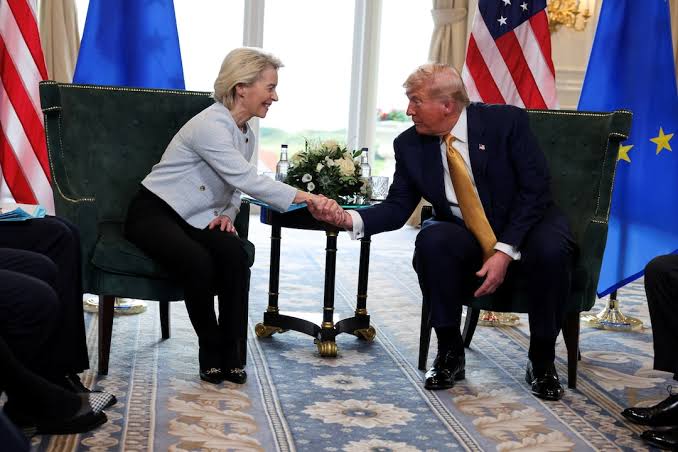
After high stakes talks at President Donald Trump’s Turnberry golf resort in Scotland, a new trade deal has been sealed between the U.S. and the EU, two of the world’s largest economic powers.
The agreement introduces a 15% tariff on all EU exports to the U.S., a significant compromise from the 30% Trump administration had earlier threatened to impose.
President Trump praised the deal, calling it “a good deal for everybody” and a move that will “bring us closer together.” European Commission President Ursula von der Leyen, who negotiated on behalf of the 27-member EU bloc, welcomed the outcome as a step toward stability and mutual benefit. She called the agreement a “framework” deal, with technical details to be ironed out in the coming weeks.
The deal includes zero tariff arrangements for certain key sectors such as aircraft components, selected agricultural products, and chemicals.
While some items escape the tariff net, others especially in the alcohol industry remain contentious, with France and the Netherlands seeking exemptions for their wine and beer exports.
In a nod to American strategic interests, the EU pledged to invest $600 billion into the U.S. economy and commit $750 billion over three years into American energy sectors such as liquefied natural gas, oil, and nuclear fuel. Von der Leyen emphasized that the move would help Europe diversify its energy sources and reduce reliance on Russia.
Despite the positive headlines, not all EU leaders were enthusiastic. France’s Minister for European Affairs, Benjamin Haddad, criticized the agreement as unbalanced, though he acknowledged it offers temporary stability for European businesses. “It protects some of our sectors like spirits, but the broader structure favors the U.S.,” he said.
Other European leaders offered cautious support. Ireland’s Taoiseach Micheál Martin noted that the higher tariffs still make trade “more expensive and more challenging.” Germany’s Chancellor Friedrich Merz emphasized the importance of stable market access, while Italy’s Prime Minister Giorgia Meloni called for a closer look at the agreement’s full implications.
Notably, the 50% U.S. tariffs on steel and aluminum imports will remain in place, a sticking point that Trump defended as necessary for protecting American industries.
Trump, who is midway through a five-day visit to Scotland, claimed the deal as a personal victory. It follows his administration’s ongoing strategy of using tariffs as leverage to reset global trade balances and shrink the U.S. trade deficit. The U.S. currently imports significantly more from the EU than it exports, with last year’s figures showing a $236 billion trade gap.
Both sides are now preparing for the next phase—ratification by EU member states and further negotiations on unresolved issues such as digital goods and semiconductors.
As the president wrapped up a round of golf with his son Eric amid overcast skies at Turnberry, attention turned to his next stops: a meeting with UK Prime Minister Keir Starmer, and a ribbon-cutting ceremony for a new Trump golf course in Aberdeen.
While the agreement represents progress, its long-term impact remains to be seen. One thing is certain, Trump leaves Scotland with what he sees as a landmark trade victory one that may redefine America’s economic posture on the global stage